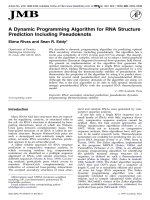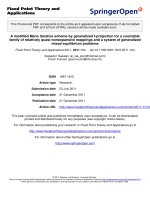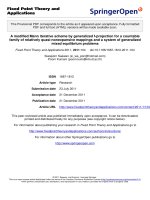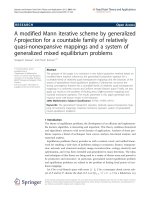A Hybrid Subgradient Algorithm for Nonexpansive Mappings and Equilibrium Problems
Bạn đang xem bản rút gọn của tài liệu. Xem và tải ngay bản đầy đủ của tài liệu tại đây (224.04 KB, 10 trang )
A Hybrid Subgradient Algorithm for Nonexpansive
Mappings and Equilibrium Problems ∗
P.N. Anh†and L.D. Muu
‡
Abstract. We propose a strongly convergent algorithm for finding a common point in
the solution set of a class of pseudomonotone equilibrium problems and the set of fixed
points of nonexpansive mappings in a real Hilbert space. The proposed algorithm uses
only one projection and does not require any Lipschitz condition for the bifunctions.
AMS 2010 Mathematics subject classification: 65 K10, 65 K15, 90 C25, 90 C33.
Keyword. Equilibrium problem, nonexpansive mapping, pseudomonotonicity, fixed point.
1
Introduction
Let H be a real Hilbert space with inner product ·, · and its reduced norm · . Let C
be a nonempty closed convex subset of H. We recall that a mapping T : C → C is said to
be a contraction on C with a constant δ ∈ (0, 1) iff
T (x) − T (y) ≤ δ x − y , ∀x, y ∈ C.
If δ = 1, then T is called nonexpansive on C. We denote by F ix(T ) the set of all fixed
points of T . It is well known that T is a closed convex set. Suppose that ∆ is an open
convex set containing C and f : ∆ × ∆ → R is a bifunction such that f (x, x) = 0 for all
x ∈ C. Such a bifunction is called an equilibrium bifunction. We consider the equilibrium
problem defined as
Find x∗ ∈ C such that f (x∗ , y) ≥ 0, for all y ∈ C.
EP (C, f )
This problem is also often called the Ky Fan inequality due to his contribution to this
field. It is well known (see e.g. [7, 14]) that some important problems such as convex
programs, variational inequalities, the Kakutani fixed point, minimax problems and Nash
equilibrium models can be formulated as an equilibrium problem of the form EP (C, f ).
We denote the set of solutions of EP (C, f ) by Sol(C, f ). Recall [7] that the bifunction f
is
∗
This work is supported by the Vietnam Institute for Advanced Study in Mathematics.
Department of Scientific Fundamentals, Posts and Telecommunications Institute of Technology,
Hanoi, Vietnam ().
‡
Institute of Mathematics, VAST ().
†
1
(i) strongly monotone on C with modulus β > 0, shortly β-strongly monotone on C,
iff
f (x, y) + f (y, x) ≤ −β y − x 2 , ∀x, y ∈ C;
(ii) monotone on C iff
f (x, y) + f (y, x) ≤ 0, ∀x, y ∈ C;
(iii) pseudomonotone on a set A ⊆ C with respect to x iff
f (x, y) ≥ 0 implies f (y, x) ≤ 0, ∀y ∈ A;
We say that f is pseudomonotone on A if it is pseudomonotone on A with respect to every
x ∈ A.
Clearly,
(i) ⇒ (ii) ⇒ (iii).
The bifunction f is said to be Lipschitz-type continuous on C with constants c1 > 0
and c2 > 0 (see e.g. [13]) iff
f (x, y) + f (y, z) ≥ f (x, z) − c1 x − y
2
− c2 y − z 2 , ∀x, y, z ∈ C.
(1.1)
A basis solution method for solving equilibrium problems is the projection method. It
is well known [9] that the projection method is not convergent for monotone variational
inequality, which is a special case of monotone equilibrium problems. In order to obtain
convergence of the projection method for equilibrium problems, the extragradient method
introduced by Korpelevics in [8] is extended to pseusomonotone equilibrium problems
[20]. However the extragradient method requires two projections onto the constrained
set C, which is computationally expensive except when C has special structure. Efforts
for avoiding and/or reducing computational costs in computing the projection have been
made by using penalty function methods [2, 6, 14, 15] and relaxing the constrained convex
set by polyhedral convex ones [3, 10]. Another idea is to considering conditions on the
bifunctions involved that enables replacing two projections by only one [16]. In [16] an
algorithm has been proposed for solving a wide class of equilibrium problems that requires
only one projection rather than two ones as in the extragradient method. Computational
results reported in [16] show efficiency of this algorithm in finite dimensional Euclidean
spaces.
The problem P (C, f, T ) of finding a common point in the solution set of Problem
EP (C, f ) and the set of fixed points of a nonexpansive mapping T recently becomes an
attractive subject, and various methods have been developed for solving this problem (see
e.g. [1, 2, 18, 19, 21, 23] and the references therein). Most of the existing algorithms for
this problem are based on the proximal point method applying to equilibrium problem
EP (C, f ) combining with a Mann’s iteration to the problem of finding a fixed point of T .
Tada and Takahashi in [19] proposed an algorithm, where at each iteration k the
iterate xk+1 is defined as follows
z k ∈ C such that f (z k , y) +
1
y − z k , z k − xk ≥ 0, ∀y ∈ C,
λk
k
k
k
w = αk x + (1 − αk )T (z ),
Ck = {z ∈ H : wk − z ≤ xk − z },
Dk = {z ∈ H : xk − z, x0 − xk ≥ 0}, xk+1 = PCk ∩Dk (x0 ),
2
(1.2)
where λk > 0 is the regularization parameter at iteration k, x0 ∈ C and PC is the metric
projection onto C. Under the main assumption that the bifunction f is monotone on C, the
sequence {xk } strongly converges to the projection of the starting point onto the solution
set of Problem P (C, f, T ), provided the sequences {λk }, {αk } satisfy some properties.
In this algorithm and some other ones using scheme (1.2), the bifunctions involved are
assumed to be monotone on C. Recently, Anh in [1] proposed to use the extragradienttype iteration instead of the proximal point iteration (1.2) for solving Problem P (C, f, T ).
More precisely, given xk ∈ C, the proximal point iteration (1.2) is replaced by the two
following mathematical programs, which seems numerically easier than (1.2)
y k = argmin{f (xk , y) +
z k = argmin{f (y k , z) +
1
2λk
1
2λk
y − xk
2
: y ∈ C},
z − xk
2
: z ∈ C}.
(1.3)
It was proved that if f is pseudomonotone and satisfies the Lipschitz-type condition ( 1.1),
then the sequence {xk } strongly converges to a solution of Problem P (C, f, T ).
It should be emphasized that the Lipschitz-type condition ( 1.1), in general is not
satisfied, and if yes, finding the constants c1 and c2 is not an easy task. Furthermore
solving the strongly convex programs ( 1.3) is expensive excepts special cases when C has
a simple structure.
The purpose of this paper is to propose a strongly convergent algorithm for solving
Problem P (C, f, T ), which is a combination of the well-known Mann iterative scheme
for fixed point [12] and the projection method for equilibrium problems. The proposed
algorithm can be considered as an extension of the one in [16] to problem P (C, f, T ) in
real Hilbert spaces.
The paper is organized as follows. In the next section we describe the algorithm and
state some lemmas which will be used in the proof for the convergence of the proposed
algorithm. The convergence analysis of the algorithm is presented in the third section.
2
Preliminaries
Let C be a nonempty closed convex subset of a Hilbert space H. We write xn
x to
n
n
indicate that the sequence {x } converges weakly to x as n → ∞, and x → x means that
{xn } converges strongly to x. Since C is closed, convex, for any x ∈ H, there exists an
uniquely point in C, denoted by PC (x) satisfying
x − PC (x) ≤ x − y , ∀y ∈ C.
PC is called the metric projection of H to C. It is well known that PC satisfies the following
properties:
x − y, PC (x) − PC (y) ≥ PC (x) − PC (y) 2 , ∀x, y ∈ H,
(2.1)
x − PC (x), PC (x) − y ≥ 0, ∀x ∈ H, y ∈ C,
(2.2)
x−y
2
≥ x − PC (x)
2
2
+ y − PC (x) , ∀x ∈ H, y ∈ C.
(2.3)
Let us assume that the bifunction f : ∆ × ∆ → R and the nonexpansive mapping T :
C → C satisfy the following conditions:
A1 . For each x ∈ C, f (x, x) = 0 and f (x, ·) is convex on C;
3
A2 . ∂ f (x, ·)(x) is nonempty for each > 0 and x ∈ C, where ∂ f (x, ·)(x) stands for
-subdifferential of the convex function f (x, .) at x;
A3 . f is pseudomonotone on C with respect to every solution of Problem EP (C, f ) and
satisfies the following condition, called paramonotonicity property
x ∈ Sol(C, f ), y ∈ C, f (y, x) = f (x, y) = 0 ⇒ y ∈ Sol(C, f );
(2.4)
A4 . For each x ∈ C, f (·, x) is weakly upper semicontinuous on the open set ∆;
A5 . The solution set S of Problem P (C, f, T ) is nonempty.
Suppose that the sequences {λk }, {βk }, { k }, {δk } of nonnegative numbers satisfy the
following conditions
0 < λ < λk < λ, 0 < a < δk < b < 1, δk → 1/2,
∞
2
(2.5)
βk > 0, ∞
k=0 βk = +∞,
k=0 βk < +∞,
∞
k=0 βk k < +∞.
We note that bifunctions satisfying ( 2.4) are used in [16], and in [11] for variational
inequality. Clearly, in the optimization problem, where f (x, y) = ϕ(y)−ϕ(x), the condition
( 2.4) is automatically satisfied.
Now the iteration scheme for finding a common point in the set of solutions of Problem
EP (C, f ) and the set of fixed points of the nonexpansive mapping T can be written as
follows:
Pick x0 ∈ C. At each iteration k = 0, 1, ... do the followings:
k
k
k
Compute w ∈ ∂ k f (x , ·)(x );
Take γk := max{λk , wk } and αk := βγkk ;
Compute y k = PC (xk − αk wk ) and let xk+1 := δk xk + (1 − δk )T (y k ).
(2.6)
To investigate the convergence of this scheme, we recall the following technical lemmas
which will be used in the sequel.
Lemma 2.1 (see [22]) Suppose that {ak } and {βk } are two sequences of nonnegative real
numbers such that
ak+1 ≤ ak + βk , k ≥ 0,
∞
βk < ∞. Then the sequence {ak } is convergent.
where
k=0
Lemma 2.2 (see [17]) Let H be a real Hilbert space, {δk } be a sequence of real numbers
such that 0 < a ≤ δk ≤ b < 1 for all k = 0, 1, · · · , and let {v k }, {wk } be sequences of H
such that
lim sup v k ≤ c, lim sup wk ≤ c,
k→∞
k→∞
and
lim δk v k + (1 − δk )wk = c, for some c > 0.
k→∞
Then, lim v k − wk = 0.
k→∞
4
3
Convergence Analysis
Now, we state and prove the main convergence theorem for the proposed iteration scheme
( 2.6).
Theorem 3.1 Suppose that Assumptions A1 - A5 are satisfied, the parameters δ, λ and
the sequences {λk }, {βk }, { k }, {δk } satisfy restrictions (2.5). Then the sequences {xk },
{y k } and {PS (xk )} generated by (2.6) strongly converge to the same point x
¯ and x
¯ =
limk→∞ PS (xk ).
The theorem is proved through several claims.
Claim 1. For every x∗ ∈ S and every k, one has
xk+1 − x∗
2
≤ xk − x∗
2
+ 2(1 − δk )αk f (xk , x∗ ) + 2(1 − δk )αk
k
+ 2(1 − δk )βk2 , (3.1)
and there exists the limit lim xk − x∗ := c.
k→∞
Proof of Claim 1. It follows from xk+1 = δk xk + (1 − δk )T (y k ) and x∗ ∈ F ix(T ) that
xk+1 − x∗
2
= δk (xk − x∗ ) + (1 − δk ) T (y k ) − T (x∗ )
≤δk xk − x∗
2
+ (1 − δk ) T (y k ) − T (x∗ )
≤δk xk − x∗
2
+ (1 − δk ) y k − x∗
=δk xk − x∗
2
+ (1 − δk ) xk − x∗
≤ xk − x∗
2
2
2
2
2
− y k − xk
2
+ 2 xk − y k , x∗ − y k
+ 2(1 − δk ) xk − y k , x∗ − y k .
(3.2)
Since y k = PC (xk − αk wk ) and x∗ ∈ C, one has
xk − y k , x∗ − y k ≤ αk wk , x∗ − y k .
Combining this inequality with (2.6) and (3.2) yields
xk+1 − x∗
2
≤ xk − x∗
2
+ 2(1 − δk ) xk − y k , x∗ − y k
≤ xk − x∗
2
+ 2(1 − δk )αk wk , x∗ − y k
= xk − x∗
2
+ 2(1 − δk )αk wk , x∗ − xk + 2(1 − δk )αk wk , xk − y k
≤ xk − x∗
2
+ 2(1 − δk )αk wk , x∗ − xk + 2(1 − δk )αk wk
= xk − x∗
2
≤ xk − x∗
2
xk − y k
+ 2(1 − δk )αk wk , x∗ − xk
βk
w k xk − y k
+ 2(1 − δk )
max{λk , wk }
+ 2(1 − δk )αk wk , x∗ − xk + 2(1 − δk )βk xk − y k .
Using again y k = PC (xk − αk wk ), xk ∈ C, it follows from (2.6) that
xk − y k
2
≤αk wk , xk − y k
≤αk wk
=
xk − y k
βk
wk
max{λk , wk }
≤βk xk − y k ,
5
xk − y k
(3.3)
which implies that xk − y k ≤ βk . Using this fact and (3.3), we get
xk+1 − x∗
2
≤ xk − x∗
2
+ 2(1 − δk )αk wk , x∗ − xk + 2(1 − δk )βk2 .
(3.4)
Since wk ∈ ∂ k f (xk , ·)(xk ), x∗ ∈ C and f (x, x) = 0 for all x ∈ C, we have
wk , x∗ − xk ≤ f (xk , x∗ ) − f (xk , xk ) +
∗
k
≤ f (x , x ) +
k
k.
(3.5)
Combining (3.4) and (3.5), we obtain the inequality (3.1). On the other hand, since
x∗ ∈ Sol(C, f ), i.e., f (x∗ , x) ≥ 0 for all x ∈ C, by pseudomonotonicity of f , we have
f (x, x∗ ) ≤ 0 for all x ∈ C. Replacing x by xk ∈ C, we get f (xk , x∗ ) ≤ 0. Then from (3.1)
and (3.4), it follows that
xk+1 − x∗
2
≤ xk − x∗
2
+ 2(1 − δk )αk
k
+ 2(1 − δk )βk2 .
(3.6)
Now applying Lemma 2.1 to (3.6), by Assumption (2.5), we obtain the existence of
c := lim xk − x∗ .
k→∞
Claim 2. lim sup f (xk , x∗ ) = 0 for every x∗ ∈ S.
k→∞
Proof of Claim 2. Since f is pseudomonotone on C and f (x∗ , xk ) ≥ 0, we have
−f (xk , x∗ ) ≥ 0. Then, by Claim 1, for every k, one has
2(1 − δk )αk [−f (xk , x∗ )] ≤ xk − x∗
2
+ 2(1 − δk )αk
≤ xk − x∗
2
− xk+1 − x∗
k
2
+ 2(1 − δk )βk2
− xk+1 − x∗
2
+ 2αk
k
+ 2βk2 .
(3.7)
Summing up the above inequalities for every k, we obtain
∞
(1 − δk )αk [−f (xk , x∗ )]
0≤2
k=0
∞
∞
≤ x0 − x∗
2
αk
+2
k=0
k
βk2 < +∞.
+2
k=0
It follows from the algorithm and Assumption (2.5) that
αk =
βk
βk
βk
βk
=
≥
≥
,
k
γk
λk
max{λk , w }
λ
which together with 0 < a < δk < b < 1 and (3.8), implies
∞
0 ≤ 2(1 − b)
βk
[−f (xk , x∗ )]
λ
k=0
∞
(1 − δk )αk [−f (xk , x∗ )] < +∞.
≤2
k=0
Thus
∞
βk [−f (xk , x∗ )] < +∞.
k=0
6
(3.8)
∞
Then, by
βk = ∞ and −f (xk , x∗ ) ≥ 0, we can deduce that lim sup f (xk , x∗ ) = 0 as
k→∞
k=0
desired.
Claim 3. For any x∗ ∈ S, suppose that {xki } is the subsequence of of {xk } such that
lim sup f (xk , x∗ ) = lim f (xki , x∗ ),
i→∞
k→∞
(3.9)
and x
¯ is a weakly limit point of {xki }. Then x
¯ solves EP (C, f ).
Proof of Claim 3. For simplicity of notation, without lost of generality, we may assume
that xki weakly converges to x
¯ as i → ∞. Since f (., x∗ ) is weakly upper semicontinuous,
(3.9), we have
f (¯
x, x∗ ) ≥ lim sup f (xki , x∗ ) = lim f (xki , x∗ )
i→∞
i→∞
k
∗
= lim sup f (x , x ) = 0.
(3.10)
k→∞
On the other hand, since f is pseudomonotone and f (x∗ , x
¯) ≥ 0, we have f (¯
x, x∗ ) ≤ 0.
∗
∗
Thus, f (¯
x, x ) = 0, which by pseudomonotonicity implies f (x , x
¯) ≤ 0. Hence f (x∗ , x
¯) = 0
Then, from Assumption (A4 ), it follows that x
¯ is a solution of EP(f, C) as well.
Claim 4. Any weakly cluster point of the sequence {xk } is a fixed point of T , in particular,
x
¯ ∈ S.
Proof of Claim 4. Let y¯ be a weakly cluster point of {xk } and {xkj } be a subsequence
of {xk } ⊂ C weakly converging to y¯. By convexity, C is weakly closed. Hence y¯ ∈ C. For
each x∗ ∈ S, by nonexpansiveness of T , we can write
T (y k ) − x∗ ≤ y k − x∗ ≤ xk − x∗ + y k − xk ≤ xk − x∗ + βk ,
which implies
lim sup T (y k ) − x∗ ≤ lim ( xk − x∗ + βk ) = c.
k→∞
k→∞
On other hand, since δk (xk − x∗ ) + (1 − δk )(T (y k ) − x∗ ) = xk+1 − x∗ , we have
lim δk (xk − x∗ ) + (1 − δk )(T (y k ) − x∗ ) = lim xk+1 − x∗ = c.
k→∞
k→∞
Then, applying Lemma 2.2 with v k := xk − x∗ , wk := T (y k ) − x∗ , it results
lim T (y k ) − xk = 0.
k→∞
(3.11)
At the same time, we have
T (xk ) − xk ≤ T (xk ) − T (y k ) + xk − T (y k )
≤ xk − y k + xk − T (y k ) ≤ βk + xk − T (y k ) .
From (3.11) and (3.12), it follows that
lim T (xk ) − xk = 0.
k→∞
7
(3.12)
Suppose in contrary that y¯ = T (¯
y ). Then, since xkj
one can write
y¯, by Opial’s Theorem and ( 3.11)
lim infj→∞ xkj − y¯ < lim infj→∞ xkj − T (¯
y)
= lim infj→∞
xkj − T (xkj ) + T (xkj ) − T (¯
y)
≤ lim xkj − T (xkj ) + lim infj→∞ T (xkj ) − T (¯
y)
j→∞
≤ lim infj→∞ xkj − y¯ ,
(3.13)
which is a contradiction. Hence y¯ = T (¯
y ). Apply Claim 3 with y¯ = x
¯ we obtain x
¯ ∈ S.
Claim 5.
lim xk = lim y k = lim PS (xk ) = x
¯.
k→∞
k→∞
k→∞
Proof of Claim 5. Since f is pseudomonotone and T is nonexpansive on C, the
solution set S is convex. It follows from (3.6) that
xk+1 − x∗
where ηk := 2(1 − δk )αk
k
2
≤ xk − x∗
2
+ ηk ,
+ 2(1 − δk )βk2 > 0 for all k ≥ 0 and
(3.14)
∞
ηk < +∞. Then, by
k=0
definition of xk+1 , we have
xk+1 − PS (xk+1 )
2
≤ δk (xk − PS (xk )) + (1 − δk )(T (y k ) − PS (xk ))
≤ δk xk − PS (xk )
2
2
+ (1 − δk ) T (y k ) − PS (xk ) 2 .
(3.15)
Now using the property( 2.3) of the metric projection we have
T (y k ) − PS (xk )
2
≤ T (y k ) − xk
2
− xk − PS (xk ) 2 ,
which, by ( 3.15), implies that
xk+1 − PS (xk+1 )
2
≤ δk xk − PS (xk )
2
+ (1 − δk ) T (y k ) − xk
− (1 − δk ) xk − PS (xk )
2
2
= (2δk − 1) xk − PS (xk )
2
+ (1 − δk ) T (y k ) − xk 2 .
(3.16)
Note that, by ( 3.11), T (y k ) − xk 2 → 0. Using this fact, by boundedness of the sequence
{xk − PS (xk )}, letting δk → 1/2 we obtain from the latter inequality that
lim xk+1 − PS (xk+1 ) = 0
(3.17)
k→∞
For simplicity of notation, let z k := PS (xk ). Then, for all m > k, since S is convex,
we have 12 (z m + z k ) ∈ S, and therefore
zm − zk
2
=2 xm − z m
2
+ 2 xm − z k
≤2 xm − z m
2
+ 2 xm − z k
=2 xm − z k
2
1
− 4 xm − (z m + z k )
2
2
m
− 4 x − zm 2
2
− 2 xm − z m 2 .
8
2
(3.18)
Since z k ∈ S, it follows from ((3.14)) with x∗ = z k that
xm − z k
2
≤ xm−1 − z k
2
+ ηm−1
≤ xm−2 − z k
2
+ ηm−1 + ηm−2
≤ ···
m−1
≤ xk − z k
2
+
ηj .
j=k
Combining this inequality with (3.18), we have
m−1
m
z −z
k 2
k
≤2 x −z
k 2
ηj − 2 xm − z m 2 ,
+2
j=k
∞
which, together with
ηk < ∞ and ( 3.17), implies that {z k } is a Cauchy sequence.
k=0
Hence, {z k } strongly converges to some point z¯ ∈ S. However, since z ki := PS (xki ),
letting i → ∞, we obtain in the limit that
x) = x
¯ ∈ S,
z¯ = lim PS (xki ) = PS (¯
i
which implies that x
¯ = z¯, and therefore, z k := PS (xk ) → z¯ = x
¯ ∈ S. Then, from
k
k
k
k
( 3.16) and z → x
¯, x − T (y ) → 0, we can conclude that x → x
¯, Finally, since
limk→∞ xk − y k = 0, we have limk→∞ y k = x
¯.
✷
References
[1] P.N. Anh, A hybrid extragradient method extended to fixed point problems and
equilibrium problems. Optim. 1(2011) 1-13.
[2] P.N. Anh, A logarithmic quadratic regularization method for solving pseudomonotone equilibrium problem. Acta Math. Vietnam. 34(2009) 183-200.
[3] P.N. Anh, and J.K. Kim, Outer approximation algorithms for pseudomonotone equilibrium problems. Comput. Math. Appl. 61(2011) 2588-2595.
[4] P.N. Anh, and D.X. Son, A new iterative scheme for pseudomonotone equilibrium
problems and a finite family of pseudocontractions. Appl. Math Infor. 29(2011) 11791191.
[5] K. Aoyama, Y. Kimura, W. Takahashi, and M. Toyoda, Approximation of common
fixed points of a countable family of nonexpansive mappings in a Banach space.
Nonlin. Anal.TMA. 67(2007) 2350-2360.
[6] A. Auslander, M. Teboulle and S. Ben-Tiba, A logaritmic quadratic proximal method
for variational inequalities Comput. Optim. Appl. 12(1999) 31-40.
[7] E. Blum and W. Oettli, From optimization and variational inequality to equilibrium
problems. Math. Student 63(1994) 127-149.
9
[8] G.M. Korpelevich, The extragradient method for finding saddle points and other
problems. Ekon. Math. Metody 12(1976) 747-756.
[9] F. Facchinei and J.S. Pang, Finite - Dimensional Variational Inequalities and Complementarity Problems. Springer, New York (2003)
[10] M. Fukushima, A relaxed projecion method for variational inequalities. Math. Prog.
35(1986) 58-70.
[11] P-E. Maig´e, Projected subgradient techniques and viscosity methods for optimization
with variational inequality constraints. Euro. Oper. Res. 205(2010) 501-506.
[12] W.R. Mann, Mean value methods in iteration, Proceedings of the American Math.
Society 4(1953). 506-510.
[13] G. Mastroeni, Gap functions for equilibrium problems. J. Glob. Optim. 27(2003)
411-426.
[14] L.D. Muu and W. Oettli, convergence of an adaptive penalty scheme for finding
constrained equilibria, Nonlin. Anal. TMA. 18(1992)1159-1166.
[15] T.T.V. Nguyen, J.J. Strodiot and V. H. Nguyen, The interior proximal extragradient
method for solving equilibrium problems, J. Glob. Optim. 40(209)175-192.
[16] P. Santos and S. Scheimberg, An inexact subgradient algorithm for equilibrium problems. Comput. Appl. Math. 30(2011)91-107.
[17] J. Schu, Weak and strong conergence to fixed points of asymptotically nonexpansive
mappings. Bulletin Australian Math. Society 43 (1991) 153-159.
[18] A. Tada and W. Takahashi, Weak and strong convergence theorems for a nonexpansive mapping and an equilibrium problem. J. Optim. Theory Appl. 133 (2007),
359-370.
[19] S. Takahashi, and W. Takahashi, Viscosity approximation methods for equilibrium
problems and fixed point problems in Hilbert spaces. Math. Anal. Appl. 331(2007)
506-515.
[20] Q.D. Tran., L.D.Muu and V.H. Nguyen, Extragradient algorithms extended to equilibrium problems. Optim. 57(2008) 749-776.
[21] P.T. Vuong, J.J. Strodiot and V. H. Nguyen, Extragradient methods and linesearch
algorithms for solving Ky Fan inequalities and fixed point problems. J. Optim. Theory
Appl. (2012) DOI 10.1007/s10957-012-0085-7
[22] H.K. Xu, Viscosity approximation methods for nonexpansive mappings. Math. Anal.
Appl. 298 (2004) 279-291.
[23] Y. Yao, Y.C. Liou, and Y.J, Wu, An extragradient method for mixed equilibrium problems and fixed point problems. Fixed Point Theory Appl.(2009)DOI
10.1155/2009/632819.
10









